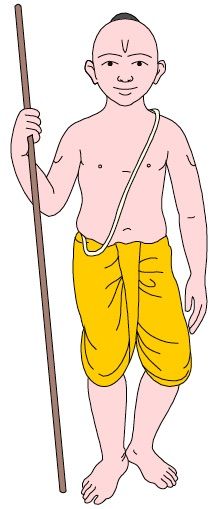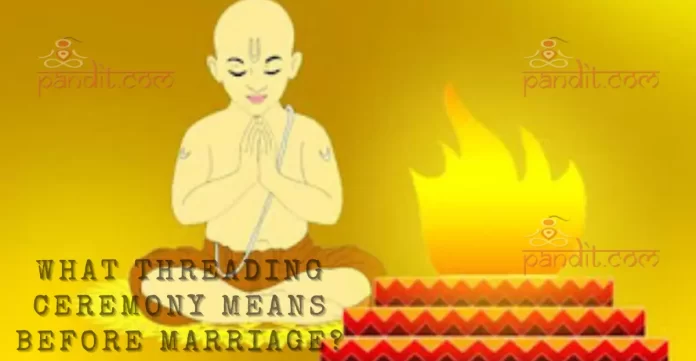A holy rite of passage ritual for all Hindus is the Threading Ceremony, or Upanayana as it is known internationally. Hindu males must perform a number of rites and procedures before wearing the sacred thread, or Janeu. It is done when a Hindu boy is growing up. It originally signaled the beginning of formal schooling for Hindu boys. Little do people realize, though, that there is an option to do this procedure much later, when a guy is preparing to get married.

What is the ritual of the Threading Ceremony?
Before a wedding, castes like Brahmins, Kshatriyas, and Vaishyas typically have a threading ritual for the groom. The ritual is also known by the name Yagnopavitra. In this ritual, the bridegroom is given three holy threads, each of which symbolizes one of his three vows: to respect knowledge, his parents, and the community in which he lives.
When does the Threading Ceremony take place?
When a Hindu boy turns seven years old, the rite of Upanayanam, or the holy Threading Ceremony, is traditionally conducted. The Upanayana rite represents the passage from one stage of a boy’s life into another. By participating in this rite, a boy leaves childhood behind and begins his journey toward manhood and wisdom. However, in contemporary times, a guy might do this ceremony after he gets married. Hindu males must participate in the Threading Ceremony before they may get married. Consequently, a Hindu groom must go through Upanayana before being married. This custom usually occurs a few days before the nuptials.
How is the Northern Thread Ritual conducted?
The threading ceremony is carried out in the following steps:
A) Lord Ganesha’s worship
A day before the wedding, the groom’s parents perform the Lord Ganesha puja. The bridegroom and his mother share a leaf plate when dining in a Brahmin household. On the day of the Upanayana, this is carried out.
B) Donning of the holy thread
The Acharya, or chief priest, then forces the groom to wear the holy thread, or Yajnopavita. This is carried out when Vedic mantras are chanted.
C) The vows dilemma
The priest gives the groom a set of vows or commitments that he must uphold throughout the rest of his life once he has walked around the fire. These include voice control, refraining from daytime naps, and Achamana, or drinking water while chanting mantras before performing any rite.
D) Lighting a holy fire using fuel sticks
Now, while Vedic mantras are chanted, the groom feeds fuel sticks to the already-built sacred fire.
E) Requesting alms
This completes the Upanayana ceremony’s process. The bridegroom asks his mother and other elderly members of his family for food. The guru must be the first to get the meal.
How is the South’s Threading Ceremony conducted?
The Threading Ceremony in a South Indian wedding is called Vrutham. It is a significant ceremony for a groom. Vrutham is held in the bridegroom’s home. On the day before the wedding, it is done quite early in the morning. With this ritual, the groom’s Brahmacharya stage comes to a conclusion and the Grihastha stage begins. A guy may only get married after this thread ritual. Before moving on to the next stage of his life, the groom first requests his father’s consent. The guru, or Acharya, is regarded as the father. When a thread is wrapped around the groom’s wrist, a puja is performed. Turmeric has been applied to this thread, which is revered. The bride is also given a ceremony at her home. The goal of this is to ward off evil spirits from harming the bride and the husband.
Understanding the Three Sacred Threads’ Symbolism
In India, the holy threads are also referred to as “Janeu.” These thread strands are not your typical thread strands. Instead, they have a deeper metaphorical significance that goes along with them. Typically, a guy can never forget three debts in his lifetime. These include:
- Man’s obligation to his mentor or instructor
- One owes one’s parents.
- Man’s obligation to academics
Three Indian deities, Parvati, Saraswati, and Lakshmi, are also represented by these threads. The groom is made to wear these strands during the holy Threading Ceremony to symbolize the significance of the three qualities that will guide him for the rest of his life. These are Parvati’s might, Saraswati’s wisdom, and prosperity (Lakshmi). It is said that a man may only be fully realized when blessed by these great goddesses. The Threading Ceremony is one of the most significant rites of passage ceremonies in a Hindu man’s life. Hinduism includes numerous holy rituals. Every family that practices Hinduism values it.
Book a Pandit Online with the help of 99pandit.com , You’ll find experienced pandits for any types of pooja all over the India. Also this site provides you the best E Puja Services.


